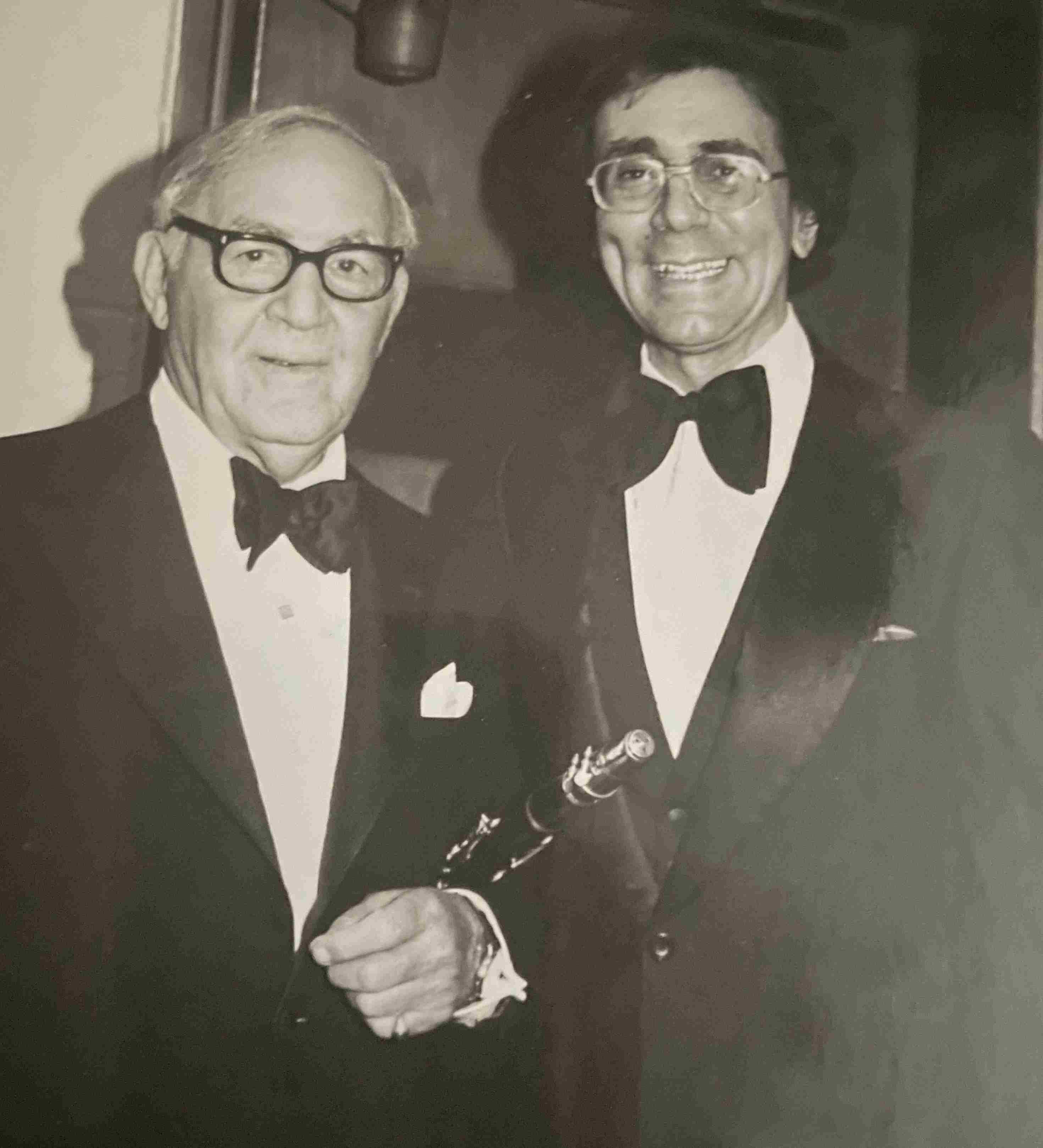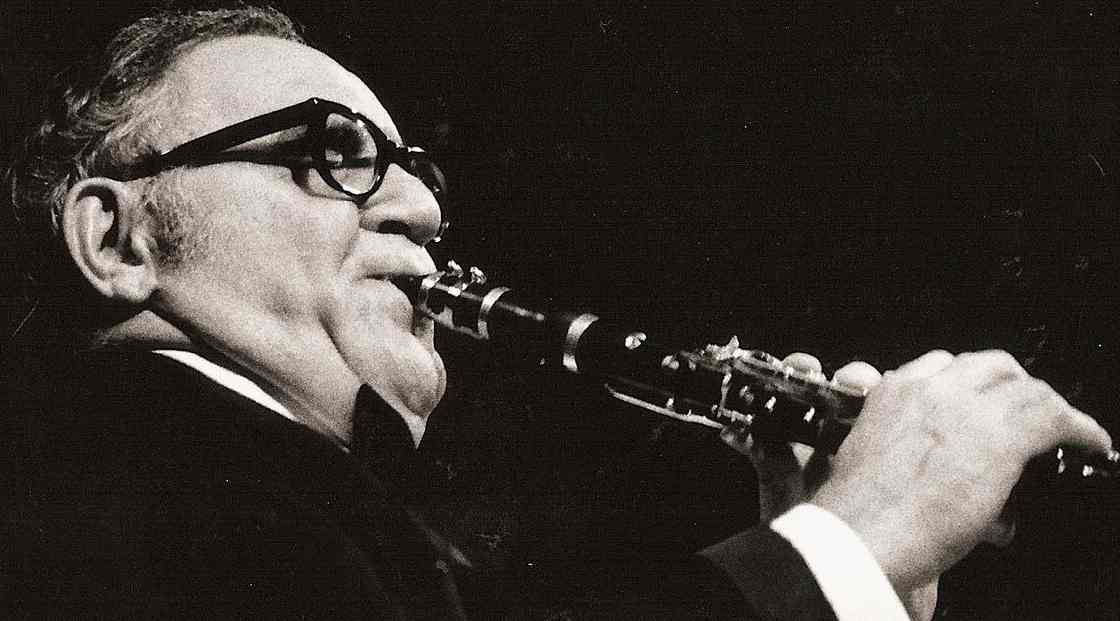As a 5-year-old
I was given a clarinet to study and I started to play. One
of the unspoken platitudes when the word ‘talent’
comes up is the learning curve development -- how long will
it take for junior to reach a respectable level of proficiency?
Most would agree that a novice youngster with real talent
will show it within six months. That was the situation in
my case and I soon got used to my grammar school teachers
oohing and aahing about my musical promise at school concert
time. They practically ordered me to audition for Gotham’s
leading conservatories and I managed acceptance at all of
them. So Saturdays I took my clarinet, packed a lunch and
subwayed to attend classes. All of the study involved classical
music and very soon I began enjoying Bach, Mozart, Schumann
etc. and other legends who wrote clarinet pieces.
One day
I began practicing a Von Weber clarinet piece and my teacher
told me to listen to what he thought was the definitive
performance of it by Benny Goodman. I was almost seven when
I heard Goodman’s recording and at the same time discovered
his jazz credentials. I instantly became hooked on Goodman’s
small group recordings (sextets, quartets) and played “’Rachel's
Dream” so often on the phonograph that
my mom began groaning. But the “King of Swing”
had indeed swung me over to jazz. It was the improvisation
 challenge
that attracted me the most and his improvisational lines
at breakneck tempos wowed me. Nevertheless it wasn’t
until I was about nine when I discovered other jazz and
became an apostle of bop.
challenge
that attracted me the most and his improvisational lines
at breakneck tempos wowed me. Nevertheless it wasn’t
until I was about nine when I discovered other jazz and
became an apostle of bop.
My relationship
to music took several turns. I continued to perform through
college and later became a jazz writer, producer, historian
and professor of this music and constantly met jazz luminaries
in interview sessions, rehearsals and seminars. Once, during
the early 60s the management of Basin Street East invited
me one night to come in and review Benny Goodman and Peggy
Lee. Goodman was at the height of his career and Lee astounded
with her beauty and lyrical genius. I interviewed Goodman
backstage after the show and discovered through his anecdotes
insights into his creative proclivities which I included
in the write-up. The master had by this time conquered movie
audiences (appearing in feel good films with Judy Garland,
Esther Williams, Van Johnson) and had nations listening
to his radio broadcasts. His legendary Carnegie Hall concert
of 1938 was instrumental in legitimizing jazz.
During
the next decade I produced a lot of big band jazz concerts:
Lionel Hampton, Buddy Rich, Woody Herman, Dave Brubeck,
Maynard Ferguson, Stan Kenton, Dizzy Gillespie, Count Basie
and countless vocalists. And if I was only rarely able to
turn a small profit, the aesthetics more than compensated.
Then one
day I succeeded in convincing Benny Goodman to star in one
of my shows. He hadn’t performed in New York for several
years and I knew sales would be brisk. We sold out two shows
in a 2500 seat theater venue in one afternoon. I was very
excited.
When Goodman
said ‘yes’ it was on the condition that I put
the band together, and that I had to book the very best
players of the day. Thank goodness I had Bucky Pizzarelli
as a good friend to help me as well as play in the group.
And so we succeeded in getting star musicians such as drummer
Mel Lewis, hornmen Scott Hamilton and Warren Vache, pianist
John Bunch, and bassist Phil Flanigan. All had performed
with Goodman for years so we knew he would be happy with
the sidemen.
I began
visiting Benny at his east side apartment to arrange the
myriad details for the concert. I was amazed to discover
that each time I got off the elevator I could hear him practicing.
It was toward the end of his career but his musical dedication
hadn’t waned and I sat there transfixed watching him
run through multi-noted exercises with wild improvisational
sequences.
When it
came time for the ‘dress’ rehearsal, I prepared
carefully not chancing rebuke from the leader. At considerable
expense I rented space at the Carlyle hotel because it was
close to Benny’s apartment. On a cold day in March,
I brought him to rehearsal and had an astounding experience.
The band members greeted him with the usual jocularity that
occurs on a bandstand. Musicians are always telling amusing
stories usually having to do with some incident that happened
either on their endless touring buses or on performance
stage somewhere.
 As
Benny removed his horn from the case he returned the friendly
greetings from the guys but there was a measure of detachment
in his demeanor. I instantly recalled the stories about
his strict control of his orchestra and limiting his fraternizing
with the sidemen. The band members also took in his comments
and rather quickly sat down, picked up their horns and sat
up in rapt attention. The atmosphere was one of a platoon
standing at attention waiting for orders.
As
Benny removed his horn from the case he returned the friendly
greetings from the guys but there was a measure of detachment
in his demeanor. I instantly recalled the stories about
his strict control of his orchestra and limiting his fraternizing
with the sidemen. The band members also took in his comments
and rather quickly sat down, picked up their horns and sat
up in rapt attention. The atmosphere was one of a platoon
standing at attention waiting for orders.
At my
Carlyle rehearsal Goodman ran up and down the scales executing
some clever interludes. And then it happened.
He finished
a sequence and instantly segued into first bar melody of
“Avalon” - a tune he had long performed. And
at the end of the measure the rest of the band was right
there at the pick up and all were off at a blistering tempo
. . . I couldn’t believe it . . . the band was roaring
and Goodman had not informed them of what tune he had selected...
Incredulously,
I accosted Bunch later on with the obvious question: “How
the hell did you guys know what tune he was going to play”?
He looked at me disdainfully and simply said, “This
is a Benny Goodman rehearsal . . . if you’re not ready
for the opening hit you won’t be playing at the next
show.”